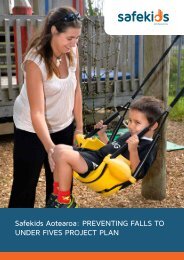Seat belts
Seat belts
Seat belts
Create successful ePaper yourself
Turn your PDF publications into a flip-book with our unique Google optimized e-Paper software.
of the strongest parts of the human<br />
anatomy - the chest and pelvis. Crash<br />
survivors will often have seat belt<br />
“burns” and bruising, or in serious<br />
cases, internal injuries, however<br />
without a seat belt, the occupant would<br />
continue to move forward in a frontal<br />
impact until brought to a stop by the<br />
windscreen, steering wheel, dashboard<br />
or front seat, with a high probability of<br />
being killed instantly. 2<br />
• Even at low speed, not wearing a seat<br />
belt can cause serious injury and death.<br />
A crash at 40km/h is like falling from a<br />
two storey building onto concrete. 5<br />
• <strong>Seat</strong> <strong>belts</strong> also perform other safety<br />
roles. Unbuckled occupants become<br />
missiles that cause injury to other<br />
occupants should they collide with<br />
them.<br />
• Airbags do not replace seat <strong>belts</strong>. <strong>Seat</strong><br />
<strong>belts</strong> hold the occupant in the correct<br />
position to maximise airbag<br />
effectiveness and are intended to<br />
supplement the seat belt.<br />
Queensland legislation 7<br />
• Everyone who travels in a passenger<br />
vehicle in Queensland is required to<br />
wear a restraint unless he or she has an<br />
exemption (see following).<br />
• The driver of a vehicle is responsible for<br />
the proper restraint of all passengers<br />
under the age of 16. Children aged<br />
under 7 years must use a child restraint<br />
suitable for their age (see Queensland<br />
Department of Transport and Main<br />
Roads’ web site www.tmr.qld.gov.au<br />
/~/media/a34d7a95-2ff5-4b5e-b57b-<br />
47aeb515d0af/child_restraints_qanda<br />
.pdf for further details. Different types<br />
of restraints are made to suit children of<br />
different ages and these provide better<br />
protection to a child who is smaller than<br />
an adult, than seat <strong>belts</strong> used alone (as<br />
these are designed to fit an adult-sized<br />
body). Once a child grows out of the<br />
booster seat (usually somewhere<br />
between ages 7-10 years), a seat belt<br />
can be used. It is safer for children to be<br />
seated in the rear seat of a vehicle with<br />
a properly adjusted restraint.<br />
• A bus driver is not responsible for<br />
ensuring passengers on the bus are<br />
wearing seat <strong>belts</strong>.<br />
• A person driving a taxi is not required to<br />
wear a seatbelt while there are<br />
passengers in the taxi.<br />
Penalties for failing to wear a seat belt<br />
New Queensland penalties for failing to<br />
wear a seat belt (for motorists and<br />
passengers) came into effect from 1<br />
November 2004. 7<br />
• Driver failure to wear a seat belt when<br />
driving a vehicle fitted with one<br />
= 3 demerit points + $300 fine.<br />
• Passenger of at least 16 years failing to<br />
wear a seat belt in a vehicle fitted with<br />
one (fine for the passenger) = 3 demerit<br />
points + $300 fine.<br />
• Driver of a vehicle failing to ensure a<br />
passenger under 16 years wears an<br />
approved restraint or seat belt (without<br />
an exemption) = 3 demerit points +<br />
$300 fine.<br />
For further information on the Queensland<br />
road rules and current traffic offence<br />
penalties, see Queensland Department of<br />
Transport and Main Roads’ “Your keys to<br />
driving in Queensland” or visit<br />
www.tmr.gov.au<br />
TIPS FOR STAYING SAFE<br />
• Wear your seat belt at all times when<br />
travelling in a vehicle. It doesn’t matter<br />
if you are only travelling a few<br />
kilometres - most road crashes happen<br />
close to home.<br />
• Ensure all occupants are safely<br />
restrained before moving.<br />
• <strong>Seat</strong> <strong>belts</strong> and restraints will only work<br />
with maximum effectiveness if correctly<br />
fitted:<br />
- They should be Australian<br />
standards approved, the correct<br />
model for the age and size of the<br />
passenger and correctly installed.<br />
Research indicates that children<br />
are being moved to larger seats or<br />
seat <strong>belts</strong> alone prematurely when<br />
this is not appropriate for their<br />
size. A child in an ill-fitting restraint<br />
is exposed to a greater risk of injury.<br />
Even babies must be in a restraint so<br />
never allow babies or children to<br />
travel on someone’s lap or in<br />
someone’s arms.<br />
- Wherever possible, lap and<br />
shoulder <strong>belts</strong> should be available<br />
in all seating positions in the<br />
vehicle.<br />
- The belt should fit snugly (not too<br />
tight or loose), positioned to pass<br />
over your pelvis and hips. The<br />
belt should not touch the wearer’s<br />
head or neck and should be<br />
adjusted so that the buckle is at or<br />
below the hip.<br />
- Pregnant women must wear the<br />
seat belt with the lap part sitting<br />
over the thighs, across the pelvis<br />
and below the unborn child, and<br />
the sash above the stomach and<br />
between the breasts.<br />
- The belt should lie flat, not<br />
twisted.<br />
- It should be in good working order.<br />
• Regularly inspect your seat <strong>belts</strong> to<br />
ensure they are safe and serviceable. A<br />
visual check and check of the belt’s<br />
operation is all that is required. They<br />
should be 6 :<br />
- clean (dirt may damage internal<br />
webbing fibres. Never use bleach<br />
or solvents.)<br />
- the webbing should not be frayed,<br />
damaged, nor sun-bleached.<br />
- the webbing should be securely<br />
attached to its end fittings and



